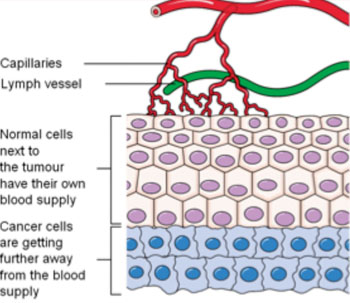Blocking the MicroRNA That Controls Angiogenesis Slows Breast Tumor Growth in a Diabetic Mouse Model
By LabMedica International staff writers
Posted on 21 Sep 2015
A team of molecular biologists demonstrated that it was possible to inhibit growth of breast tumors in a diabetic mouse model by injecting the animals with an antagonist of the microRNA (miRNA) that controls the process of angiogenesis (formation of new blood vessels).Posted on 21 Sep 2015
Investigators at the Cleveland Clinic (OH, USA) had reported previously that angiogenesis in response to hyperglycemia in a cell- and tissue-specific manner was regulated by a novel pathway under the control of the microRNA miR-467. A microRNA is a member of the class of RNA fragments about 20 nucleotides long that block gene expression by attaching to molecules of messenger RNA (mRNA) in a fashion that prevents them from transmitting the protein synthesizing instructions they had received from the DNA.

Image: Without angiogenesis a tumor cannot grow beyond a limited size (Photo courtesy of Wikimedia Commons).
In the current study, the investigators examined whether systemic administration of an antagonist of miR-467 would prevent hyperglycemia-induced local angiogenesis in a tissue-specific manner. To this end they studied the effect of the antagonist on hyperglycemia-induced tumor growth and angiogenesis and on skin wound healing in mouse models of diabetes.
They reported in the September 2015 issue of the FASEB Journal that the systemic injection of the antagonist prevented hyperglycemia-induced angiogenesis and growth of mouse and human breast cancer tumors, where the miR-467 pathway was active in hyperglycemia. In tissues where the miR-467–dependent mechanism was not activated by hyperglycemia, there was no effect of the antagonist: the systemic injection did not affect skin wound healing or the growth of prostate tumors. The antagonist did not have any effect on organs or tissues unaffected by increased blood vessel growth.
"Complications of diabetes are the main reason for mortality and hospitalization of diabetic patients. The advanced methods of measuring and regulation of the blood sugar levels resulted in deaths from diabetic coma being very rare, but the vascular complications remain an important problem that leads to mortality and loss of quality of life," said Dr. Olga Stenina-Adognravi, a researcher in the department of molecular cardiology at the Cleveland Clinic. "Developing a new organ-specific way to prevent and treat the vascular complications and cancer growth in diabetic patients is the goal of our work."
Related Links:
Cleveland Clinic













